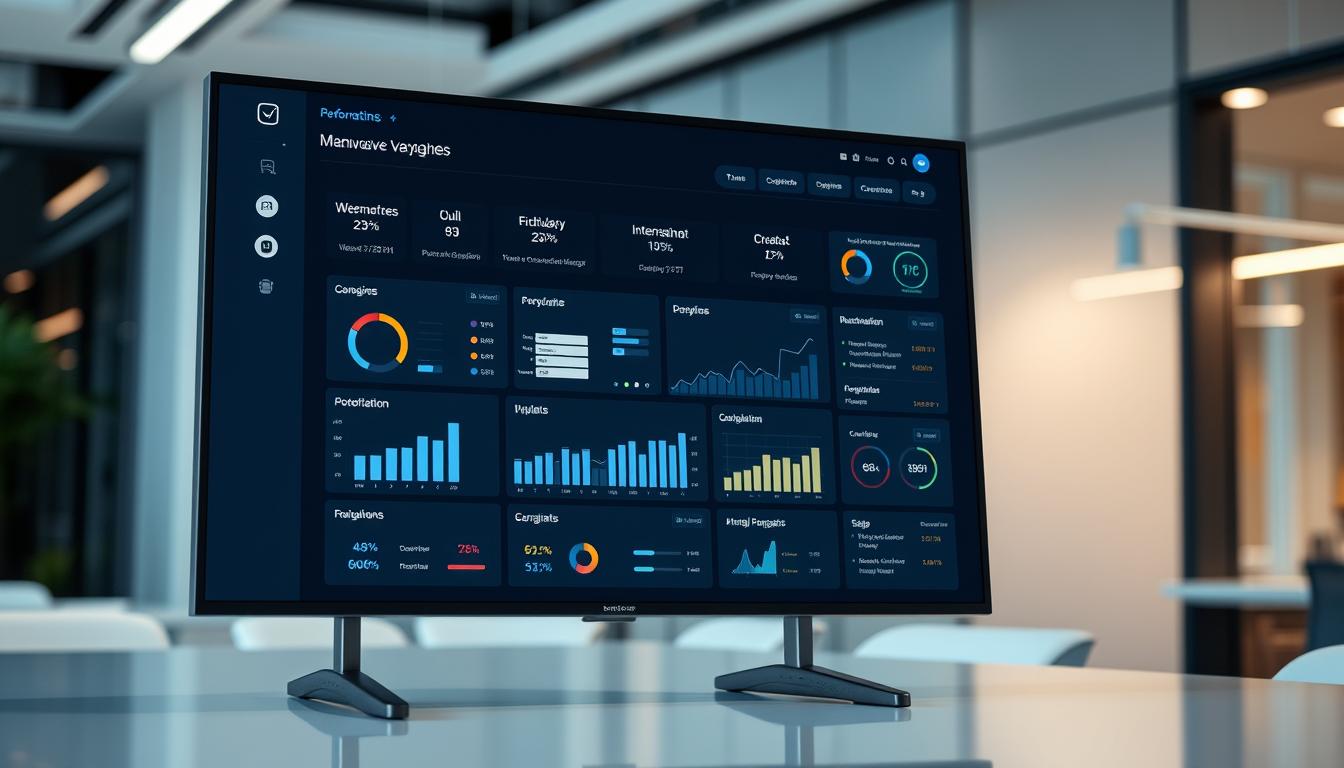Imagine your finance team working late to fix data from 12 spreadsheets before a big meeting. This is common. Over 92% of companies say their tech doesn’t link goals with current data. This leaves leaders stuck, costing $2.6 trillion worldwide.
Modern business intelligence software fixes this by combining planning, budgeting, and forecasting. I’ve seen CFOs use these tools to cut reporting time by 67%. They also make KPIs match across departments. Now, 51% of finance leaders focus on non-financial goals like efficiency.
These tools do more than just organize spreadsheets. They let teams test scenarios, track cash flow live, and make compliance a strength. With one shared dashboard, even small companies can move quicker than big ones.
Key Takeaways
- 92% of businesses struggle with fragmented systems that delay critical insights
- Integrated platforms reduce manual reporting tasks by up to 80%
- KPI alignment across teams improves strategic execution by 3x
- Real-time financial agility helps companies adapt to market shifts faster
- Advanced analytics turn compliance data into proactive decision support
What Is Corporate Performance Management Software?
Corporate Performance Management (CPM) software is like the brain of a company. It turns data into plans that help the business grow. It connects all parts of the company, from HR to supply chain, to meet goals.
Think of it as a GPS for success. It helps the company stay on track, even when things change.
Table of Contents
Strategic Alignment Through Technology
CPM tools link big plans to everyday actions. For example, Prophix One’s connected planning feature links financial plans with sales and production. This lets teams adjust fast when the market changes.
This isn’t just about numbers. It’s about speaking the same language of success across the company.
“CPM solutions transform static budgets into dynamic roadmaps, enabling organizations to pivot faster than competitors.”
Many think CPM is the same as Financial Performance Management (FPM). But they’re not the same. CPM looks at more than just money. It also considers things like customer happiness and how well employees are doing.
This way, different parts of the company work together better. This avoids problems that happen when they don’t.
Core Functionality Breakdown
Modern enterprise performance management systems are great at three things:
- KPI dashboard tools that show how close you are to your goals
- Automated budgeting that replaces old spreadsheets
- Scenario modeling to test plans against big changes
These features make strategic planning software more than just a report maker. For example, SAP Analytics Cloud uses AI to spot budget problems early. This gives finance teams a clear view of risks and chances.
Why Modern Organizations Require CPM Solutions

In today’s fast-paced markets, quick decision-making is key. Performance reporting software turns slow financial teams into fast strategists. These tools fix big problems and bring new ways to work better.
Addressing Contemporary Financial Challenges
Slow decisions cost a lot – 57% of leaders say they miss chances because of delays. Old spreadsheets can’t handle today’s needs like quick scenario tests or combining money from different places. Health Connect America, for example, got 93% budget accuracy with Prophix One’s auto variance checks.
“Our CPM platform lets us simulate merger impacts in hours, not weeks. That agility directly impacts patient service quality.”
Automating rules is also crucial. With 73% of finance teams having trouble with standard metrics, modern budgeting and forecasting solutions keep numbers the same everywhere. This stops the trouble of different versions during audits.
Operational Advantages Achieved
CPM tools make work flow better. One factory cut month-end work from 4.5 days to 2 with auto checks. Another improved 32% in expense forecasting with smart predictions in their software.
Teams work better together with shared dashboards. Sales and finance can align on goals, like meeting sales targets. These tools also save time – analysts get 11 hours back each week for important tasks.
Critical Features in Performance Management Systems

A good performance management system does more than just track numbers. It must bring together key features that help reach the company’s goals. Every enterprise performance management system is different. But, there are three main things that make a system great: it must handle data well, offer deep analysis, and work well for teams.
Unified Data Management
Today’s companies deal with lots of data from different places. Oracle Hyperion Planning shows how to manage this by combining financial and operational data in one place. For example, SoundOff Signal saw its income forecast accuracy go up by 16.7% after using a unified dashboard. Key features include:
- Automated data validation rules
- Cross-platform synchronization
- Real-time source system monitoring
Advanced Analytical Tools
Great systems turn numbers into useful insights. SAP Analytics Cloud is known for its predictive modeling, looking ahead 18 months. With a good data visualization tool, teams can:
- Find out why margins are falling
- Keep an eye on important KPIs
- Compare different scenarios
Collaboration and Adaptability
Old-fashioned spreadsheets can hold teams back. 64% of finance teams say they face delays because of version conflicts. Workday Adaptive Planning and OneStream XF offer solutions with features like threaded comments and approval chains. Important parts include:
- Role-based access controls
- Mobile-optimized interfaces
- Drag-and-drop module builders
These features don’t just make things run smoother. They help teams come together based on data, not disagreements.
Top 7 Corporate Performance Management Software Tools for 2025
Choosing the right corporate performance management (CPM) software is key. It must offer advanced analytics, easy integration, and grow with your needs. I looked at top tools using three main criteria: automation depth, cross-platform compatibility, and predictive accuracy. These tools help tackle today’s financial challenges and give insights through KPI dashboard tools.
1. Oracle Hyperion Planning
Oracle’s tool is great for detailed scenario planning. It lets finance teams test 12+ economic factors at once. It also connects ERP, CRM, and old systems well, which is vital for companies with many currencies.
Hyperion makes forecasting 37% faster than old methods.
“Hyperion’s rolling forecasts adapt faster to market shifts than static annual budgets.”
2. OneStream XF MarketPlace
OneStream leads in automating financial close, making month-end reports 45% quicker. It has prebuilt connectors for big names like SAP and Workday. Its AI finds big errors with 98% accuracy.
3. Workday Adaptive Planning
Workday uses machine learning in its financial planning and analysis software. It makes cash flow models hourly. It also works well with HR systems, adjusting costs for changing staff sizes.
It’s cheaper than SAP for smaller companies.
4. SAP Analytics Cloud
SAP tracks production line efficiency with IoT, linking to ERP for real-time dashboards. But, it’s complex to customize, adding 3-4 weeks to setup. It’s best for big companies with IT teams.
| Feature | Oracle | OneStream | Workday | SAP |
|---|---|---|---|---|
| Scenario Models | 12+ variables | 8 variables | ML-driven | IoT-enabled |
| Implementation Time | 14 weeks | 10 weeks | 8 weeks | 18 weeks |
| Budget Accuracy* | 91% | 93% | 89% | 87% |
*Prophix One achieves 93% accuracy versus Vena Solutions’ 84% in spreadsheet-heavy workflows.
Effective CPM Implementation Strategies

McKinsey says only 41% of digital changes work out. To succeed, focus on structured deployment and data-first integration. This way, you can avoid being in the 59% that fails.
Phased Deployment Approach
Don’t rush CPM adoption. It can overwhelm your team. Instead, use a six-stage rollout:
- Begin with AP automation to gain trust in the budgeting and forecasting solution
- Add financial consolidation workflows
- Implement scenario modeling
- Expand to department-level planning
- Integrate predictive analytics
- Enable enterprise-wide collaboration
Deloitte found that setting success metrics early leads to 3x faster ROI. A manufacturing client saw 20% better KPI alignment in 90 days using this method.
Integration Planning Priorities
Your performance reporting software must work well with current systems. Focus on:
- ERP data mapping (e.g., Anaplan’s Salesforce connector reduces sync errors by 38%)
- Real-time CRM updates
- Legacy system retirement timelines
I choose API-first platforms that adjust to workflow changes easily. This helped a retail chain boost forecast accuracy by 27%. They also cut manual data entry by 300 hours a month.
Common CPM Implementation Pitfalls
Despite the clear benefits of enterprise performance management systems, 90% of digital transformation efforts fail. This is due to preventable errors. I’ve seen two main issues that stop strategic planning software from working well. These problems come from both human mistakes and technical problems.
Training Program Shortcomings
BambooHR’s 2024 rollout shows how generic training programs can fail. They used a one-size-fits-all approach, ignoring the needs of different departments. This led finance teams to use budget forecasting modules wrongly.
Employees need training that matches their job. This training should be like real-life scenarios.
Effective change management needs:
- Pre-launch competency assessments
- Interactive sandbox environments
- Post-implementation reinforcement cycles
Data Quality Oversights
Jedox’s failed manufacturing implementation showed a key point: even advanced analytics fail without good data. One car company found 37% of expense codes were not set up right. This made them delay their launch by six months.
Prophix One’s automated checks help avoid these problems. It does this through:
- Real-time data checks
- Cross-system alerts
- Historical pattern analysis
| Pitfall | Business Impact | Preventive Solution |
|---|---|---|
| Inadequate Training | 42% slower user adoption | Customized learning paths |
| Unvalidated Data | 31% reporting errors | Automated mapping tools |
| Legacy System Clashes | 19% workflow disruptions | API-first integration |
Emerging Trends in Financial Performance Management
In 2025, AI and advanced visualization are changing how we look at financial data. Companies want tools that can predict and share insights easily. Let’s look at two big changes.
Artificial Intelligence Integration
Workday Adaptive Planning uses AI to make forecasts 40% faster than before. OneStream XF MarketPlace has NLP analytics for quick questions. These tools learn and adjust as the market changes.
Security is key—78% of CFOs focus on cyber risk with business intelligence software. SAP adds real-time threat detection to AI, keeping things safe and efficient.
Enhanced Visualization Technologies
SAP Analytics Cloud has AR dashboards for 3D models in virtual meetings. Prophix One’s mobile scorecards update KPIs every 15 minutes. Gartner says 65% of companies will use these tools by 2025.
These data visualization tools make complex data easy to understand. A manufacturing client cut budget meetings in half with dynamic heatmaps.
Conclusion
Today’s businesses need more than just spreadsheets. Corporate performance management software helps link strategy to action. PwC found that using these tools can cut down on decision-making time by 57%.
Tools like Workday Adaptive Planning and OneStream XF MarketPlace help reduce budget variances. They do this by modeling scenarios in real-time. This cuts down budget variances from 16.1% to 1.1%.
Financial planning and analysis software turns challenges into chances. SAP Analytics Cloud users saw their supply chain response times improve by 43% during recent crises. These systems make sense of scattered data, helping teams make forecast adjustments before quarterly reviews.
Choosing the right software means it fits with your business’s rhythm. TrustRadius shows 68% of successful implementations start with audits. Tools from Oracle and Anaplan help figure out how much you can save before you start.
I suggest looking for platforms with AI for finding patterns and easy-to-use dashboards. The best corporate performance management software speeds up decision-making. It turns financial teams into strategic partners during market changes.






0 Comments